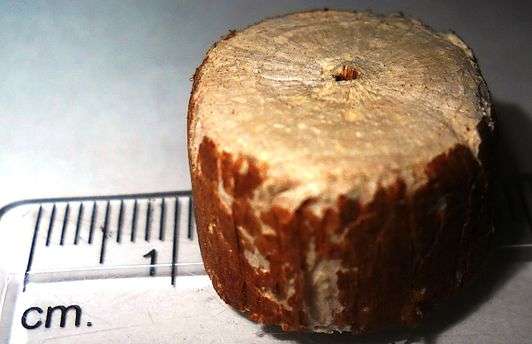Aeschynomene aspera
| Sola | |
|---|---|
| Scientific classification | |
| Kingdom: | Plantae |
| (unranked): | Angiosperms |
| (unranked): | Eudicots |
| (unranked): | Rosids |
| Order: | Fabales |
| Family: | Fabaceae |
| Genus: | Aeschynomene |
| Species: | A. aspera |
| Binomial name | |
| Aeschynomene aspera | |
| Synonyms | |
| |

Aeschynomene aspera is a species of flowering plant in the family Fabaceae. It is also known by the names sola, shola (Bengali শোলা) sola pith plant, pith plant, laugauni (Hindi)[1] or Netti (Tamil) .[2] Pith of low density from this plant is used to make hats known as pith helmets or sola topis.
It is native to Bangladesh, Bhutan, Cambodia, India, Indonesia, Laos, Malaysia, Myanmar, Nepal, Pakistan, Sri Lanka, Thailand, and Vietnam.
It is an aquatic plant and is considered a minor weed of rice paddies across its range.[3]
Used part
From the biological viewpoint, the used part is the wood of the stem (often mistaken as pith, but it is not).[4]
Aeschynomene sp. woods is one of the lightest woods in the world.[5][6][7] Aeschynomene woods feel like a piece of thermocol or even lighter, and have a corky texture. It is bright white to off-white (white with a slight reddish or yellowish tinge) in color.
This corky material is used to make some traditional Indian crafts and artworks, and also decorative objects for worship, etc.

See also
References
- ↑ "Indian Joint Vetch". Flowers of India. Retrieved 11 April 2015.
- ↑ Burnell, A.; Henry Yule (1996). A Glossary of Colloquial Anglo-Indian Words And Phrases: (Hobson-Jobson). Routledge.
- ↑ Caton, B. P.; M. Mortimer; J. E. Hill (2004). A practical field guide to weeds of rice in Asia. International Rice Research Institute. pp. 12–13.
- ↑ http://tropical.theferns.info/viewtropical.php?id=Aeschynomene+indica
- ↑ https://books.google.co.in/books?id=zs_lGeGsuaAC&lpg=PA888&ots=sJXL8V2PhD&dq=Lightest%20wood%20aeschynomene&pg=PA888#v=onepage&q=Lightest%20wood%20aeschynomene&f=false
- ↑ http://tropical.theferns.info/viewtropical.php?id=Aeschynomene+indica
- ↑ http://patch.com/minnesota/roseville/is-balsa-the-lightest-wood-in-the-world
- International Legume Database & Information Service. "Aeschynomene aspera". LegumeWeb. Retrieved 2007-11-18.
- "Aeschynomene aspera". Flora of Pakistan. Retrieved 2007-10-02.
- "Aeschynomene aspera". Germplasm Resources Information Network (GRIN). Agricultural Research Service (ARS), United States Department of Agriculture (USDA). Retrieved 2007-10-02.